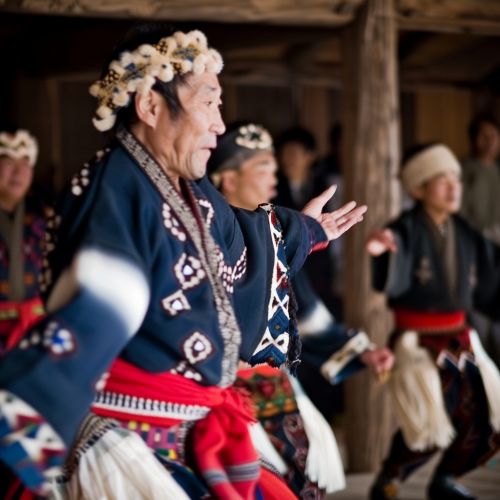Indigenous peoples of Japan
Overview
The indigenous peoples of Japan are the ethnic groups that have historically inhabited the Japanese archipelago prior to the arrival of the Yamato people, who are the ancestors of the modern Japanese population. The primary indigenous groups in Japan are the Ainu, the Ryukyuan, and the Emishi. These groups have distinct languages, cultures, and histories that predate the formation of the modern Japanese state.
Ainu People
The Ainu people are indigenous to the northern regions of Japan, particularly Hokkaido, as well as parts of Russia such as the Kuril Islands and Sakhalin. The Ainu have a unique language, which is considered a language isolate, meaning it has no known relation to any other language.
History
The Ainu are believed to be descendants of the Jomon people, who inhabited Japan from around 14,000 BCE to 300 BCE. The Jomon culture is characterized by its pottery, which is among the oldest in the world. The Ainu maintained a hunter-gatherer lifestyle, relying on fishing, hunting, and foraging. They had a rich spiritual culture centered around animism, believing that spirits inhabited all natural things.
Culture
Ainu culture is distinct and includes traditional clothing made from woven fibers and animal skins, intricate tattooing practices, and a unique form of oral literature known as "yukar." The Ainu also have a traditional dance called "Ainu Reka," which is performed during festivals and ceremonies.


Modern Issues
The Ainu have faced significant challenges, including forced assimilation policies by the Japanese government during the Meiji period. These policies aimed to eradicate Ainu culture and language. In recent years, there has been a resurgence of interest in Ainu culture, and the Japanese government officially recognized the Ainu as an indigenous people in 2008.
Ryukyuan People
The Ryukyuan people are indigenous to the Ryukyu Islands, which include Okinawa and the Amami Islands. The Ryukyuan languages are part of the Japonic language family but are distinct from standard Japanese.
History
The Ryukyu Kingdom was an independent kingdom from the 15th to the 19th century, known for its maritime trade and unique culture. The kingdom was annexed by Japan in 1879, leading to significant cultural and political changes.
Culture
Ryukyuan culture is characterized by its unique music, dance, and religious practices. The traditional music of the Ryukyus includes the use of the "sanshin," a three-stringed instrument. Ryukyuan dance, known as "Eisa," is performed during the Obon festival to honor the spirits of ancestors.
Modern Issues
The Ryukyuan people have faced cultural assimilation and economic challenges. There has been a growing movement to preserve and revitalize Ryukyuan languages and cultural practices. The presence of U.S. military bases in Okinawa has also been a contentious issue, impacting the local population.
Emishi
The Emishi were an indigenous people who lived in the Tohoku region of northern Honshu. They are believed to be related to the Ainu and were known for their resistance to the Yamato state during the early historical period of Japan.
History
The Emishi are first mentioned in Japanese historical records during the Nara period. They were known for their skills in horseback riding and archery. The Yamato state conducted several military campaigns against the Emishi, eventually leading to their assimilation.
Culture
Little is known about the specific cultural practices of the Emishi due to their assimilation and the lack of written records. However, archaeological evidence suggests that they had a distinct material culture, including unique pottery styles and burial practices.
